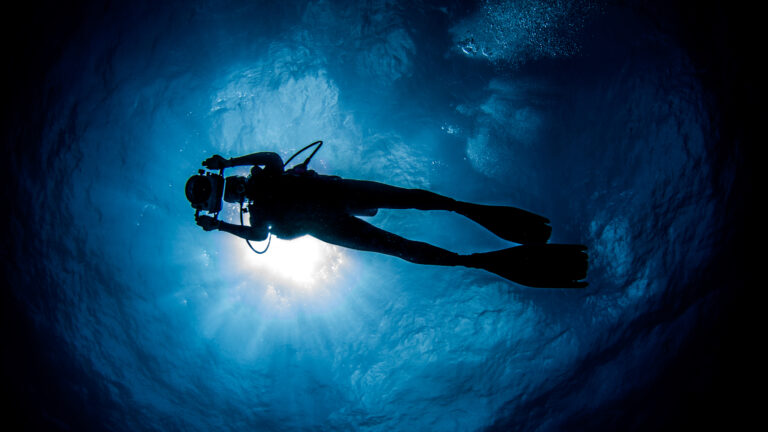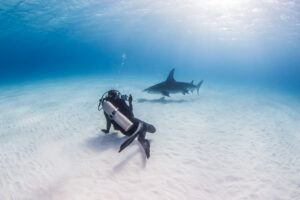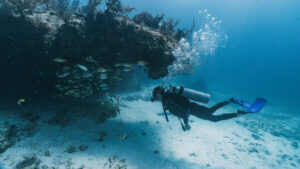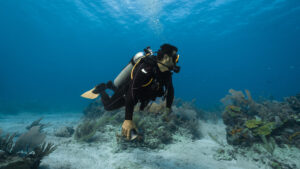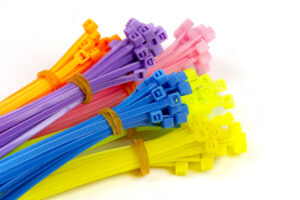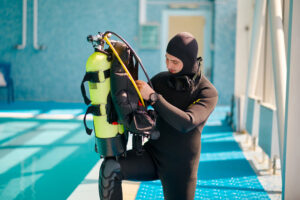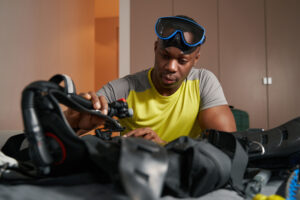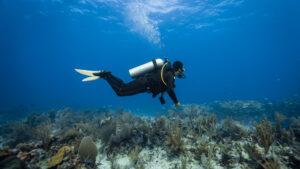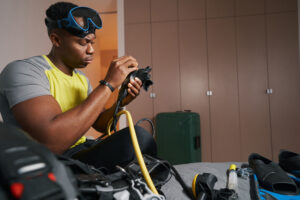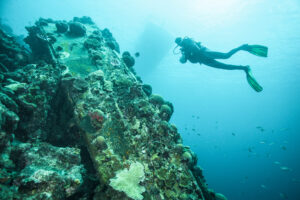What is Open Circuit Scuba?
Open circuit scuba diving is a method of underwater diving in which the diver breathes from a tank of compressed gas and exhales directly into the water. This system is contrasted with closed-circuit systems, where exhaled gas is recycled and re-breathed. Open circuit scuba is the most common and widely used system in both recreational and professional diving. It is valued for its simplicity, reliability, and the extensive training programs available to certify divers. The ease of use and availability of open circuit scuba equipment have made it a cornerstone of underwater exploration.
Historical Development
The development of open circuit scuba systems can be traced back to the early 20th century, with significant advancements occurring during and after World War II. The pioneering work of inventors such as Jacques-Yves Cousteau and Émile Gagnan was crucial in the development of modern scuba diving. In 1943, Cousteau and Gagnan developed the Aqua-Lung, the first commercially successful open circuit scuba system. This invention revolutionized underwater exploration by providing divers with a reliable and portable means of breathing underwater.
Initially, open circuit scuba was primarily used by the military for underwater demolition and reconnaissance missions. However, its potential for recreational use quickly became apparent. In the 1950s and 1960s, the popularity of scuba diving surged, fueled by media portrayals and the establishment of diving clubs and training organizations. These developments made scuba diving accessible to the general public, leading to a proliferation of diving activities worldwide.
Technological advancements continued to improve the safety and functionality of open circuit scuba systems. Innovations such as the demand regulator, which provides air only when the diver inhales, and the development of more durable and lightweight materials for tanks and gear, enhanced the diving experience. Today, open circuit scuba systems are highly advanced, offering divers a safe and enjoyable way to explore underwater environments.
Components and Functionality
An open circuit scuba system consists of several key components that work together to facilitate underwater breathing. The primary component is the regulator, which controls the flow of air from the tank to the diver. The regulator has two stages: the first stage reduces the high pressure of the compressed air in the tank to an intermediate pressure, and the second stage delivers air to the diver on demand, at ambient water pressure.
The scuba tank, typically made of aluminum or steel, stores compressed air or other breathing gases. Tanks come in various sizes, commonly ranging from 10 to 18 liters (2.6 to 4.8 gallons), and are rated for different pressure levels. The choice of tank depends on factors such as the dive plan, the diver’s air consumption rate, and the depth and duration of the dive.
Another crucial component is the buoyancy control device (BCD), which allows divers to control their buoyancy underwater. The BCD is an inflatable vest that can be adjusted by adding or releasing air, enabling the diver to achieve neutral buoyancy and maintain a desired depth. Proper use of the BCD is essential for safe and efficient diving, as it helps to prevent uncontrolled ascents or descents.
In addition to these main components, an open circuit scuba system includes other essential gear such as the dive mask, fins, and exposure suit. The dive mask creates an air space in front of the diver’s eyes, allowing for clear vision underwater. Fins provide propulsion, making it easier to move through the water. Exposure suits, including wetsuits and drysuits, provide thermal protection and help maintain body temperature in different water conditions.
Maintaining and regularly inspecting scuba equipment is vital for ensuring safety and performance. Divers must follow manufacturer guidelines for servicing and storing their gear, and perform pre-dive checks to verify that all components are functioning correctly. Proper maintenance helps prevent equipment failure and extends the lifespan of the gear.
Types of Open Circuit Systems
Open circuit scuba systems come in various configurations to suit different diving environments and requirements. The most common configuration is the single-tank system, where the diver carries one tank of compressed air on their back. This setup is suitable for most recreational diving activities and provides adequate air supply for typical dive durations.
Twin-tank configurations are used for more demanding dives, such as deep dives, technical dives, and extended bottom times. In this setup, the diver carries two tanks, which can be manifolded together or used independently. Twin-tank systems offer increased gas supply and redundancy, enhancing safety and allowing for more extended and deeper dives.
Specialized configurations are also available for specific environments, such as cold water, cave, and wreck diving. Cold water diving requires equipment that can withstand lower temperatures and prevent freezing. Divers use regulators designed for cold water, as well as thicker exposure suits and additional thermal protection. Cave and wreck diving involve navigating through confined spaces, necessitating streamlined gear and additional safety measures. Divers often use side-mount configurations, where tanks are mounted on the sides instead of the back, providing better maneuverability and access in tight spaces.
The choice of open circuit scuba system depends on the diving conditions, objectives, and the diver’s level of training and experience. Each configuration has its advantages and considerations, and divers must select the appropriate system to ensure safety and optimize their diving experience.
Training and Certification
Training is essential for anyone wishing to engage in open circuit scuba diving. Scuba training programs are designed to teach divers the necessary skills, knowledge, and safety procedures to dive safely and competently. Training begins with basic certification courses, such as the Open Water Diver course offered by organizations like PADI (Professional Association of Diving Instructors) and NAUI (National Association of Underwater Instructors).
The Open Water Diver course includes both theoretical and practical components. Classroom sessions cover topics such as dive physics, physiology, equipment, and dive planning. Practical training takes place in confined water environments, such as swimming pools, where students learn essential skills like mask clearing, buoyancy control, and emergency procedures. The course culminates in open water dives, where students apply their skills in a natural underwater setting under the supervision of an instructor.
Upon successful completion of the Open Water Diver course, divers receive certification, allowing them to dive independently within certain limits. Further training is available for those who wish to expand their skills and explore more challenging diving activities. Advanced courses, such as the Advanced Open Water Diver and Rescue Diver courses, build on basic skills and introduce new techniques and knowledge. Specialized courses, such as Nitrox, Deep Diving, and Underwater Photography, allow divers to pursue specific interests and enhance their diving abilities.
Certification levels and training standards are established by various organizations, ensuring a consistent and high-quality education for divers worldwide. Certified divers are expected to adhere to safety protocols, dive within their limits, and continue practicing and improving their skills through regular diving and additional training.
Safety Considerations
Safety is paramount in open circuit scuba diving, and divers must be aware of the risks and take appropriate precautions. Common risks include decompression sickness, barotrauma, and nitrogen narcosis. Decompression sickness, also known as “the bends,” occurs when dissolved gases in the body form bubbles due to rapid ascent and inadequate decompression. Barotrauma refers to injuries caused by pressure changes, such as lung over-expansion or ear and sinus injuries. Nitrogen narcosis is a condition caused by breathing nitrogen at high pressure, leading to impaired judgment and coordination.
To mitigate these risks, divers must follow safety practices and procedures. Proper dive planning is essential, including determining maximum depth, bottom time, and required decompression stops. Divers should use dive tables or dive computers to monitor their exposure to nitrogen and ensure they stay within safe limits. Ascending slowly and performing safety stops helps reduce the risk of decompression sickness.
The buddy system is a fundamental safety practice in scuba diving. Diving with a buddy provides mutual assistance and support in case of emergencies. Buddies should remain close to each other, communicate effectively, and be prepared to assist with problems such as equipment malfunctions or out-of-air situations. Regular practice of emergency procedures, such as sharing air and performing controlled ascents, enhances safety and preparedness.
Equipment maintenance and pre-dive checks are crucial for preventing malfunctions and ensuring reliable performance. Divers should inspect their gear before each dive, checking for issues such as leaks, damaged hoses, and proper functioning of the regulator and BCD. Carrying redundant equipment, such as an alternate air source and dive knife, provides additional safety measures.
Diving within one’s limits and obtaining proper training for specialized activities are essential for minimizing risks. Divers should avoid pushing their physical and mental limits, and seek additional training for advanced dives such as deep, cave, or wreck diving. Awareness of environmental conditions, such as currents, visibility, and water temperature, also contributes to safe diving practices.
Environmental Impact
Open circuit scuba diving can have significant environmental impacts if not conducted responsibly. Divers must be mindful of their actions and strive to minimize their ecological footprint. One major concern is physical damage to marine habitats, such as coral reefs. Contact with corals, either intentionally or accidentally, can cause breakage and harm to these delicate organisms. Divers should maintain good buoyancy control to avoid touching or kicking the reef and practice proper finning techniques.
Another environmental concern is the disturbance of marine life. Divers should avoid chasing, touching, or feeding animals, as these actions can disrupt their natural behavior and cause stress. Observing marine life from a respectful distance helps preserve their natural environment and ensures sustainable interactions. Some dive operators and organizations promote marine conservation by educating divers about best practices and encouraging participation in conservation efforts.
Marine debris, such as plastic waste and discarded fishing gear, poses a significant threat to marine ecosystems. Divers can contribute to environmental protection by participating in underwater clean-up activities and removing debris from dive sites. Reporting and documenting marine pollution incidents can also aid in addressing environmental issues.
Efforts to protect and conserve marine environments are supported by many diving organizations and initiatives. Programs such as Project AWARE, a global movement for ocean protection, engage divers in conservation activities and advocate for sustainable diving practices. By promoting environmental awareness and responsible behavior, divers can help preserve the underwater world for future generations.
Key Takeaways
Open circuit scuba diving is a widely practiced method of underwater exploration, characterized by its simplicity and reliability. It involves using a tank of compressed gas and a regulator to breathe underwater, with exhaled air released into the water. The system’s development, components, training, safety considerations, and environmental impact are all critical aspects of understanding and practicing open circuit scuba diving responsibly. Maintaining safety, respecting marine environments, and continuing education are essential for divers to enjoy and protect the underwater world.

